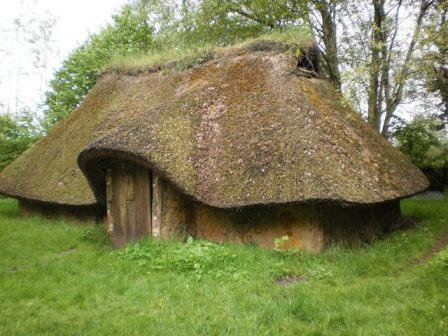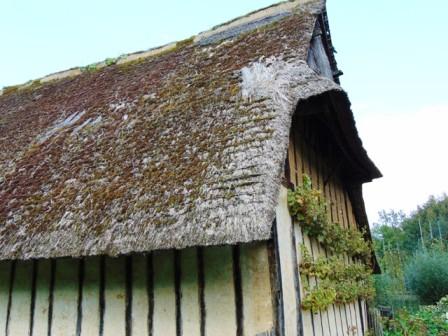The main part of the house is the roof.
If moisture seeps in walls and materials go moldy and rot, and you live unhealthy. To the structure fails.
 The load-bearingstructureconsists of beams that cansupport the weight of the roof.
The load-bearingstructureconsists of beams that cansupport the weight of the roof.
Fora good roofyouuseasweatherproofmaterial as possible. Often thiswereregion-types (and sustainable) material.
Ultimately, it will surely fail.
Straw sometimes after a few years.
Slates and tiles after several decades.
It is important that the roof has a steep uphill.
Water must be removed quickly, and the roof must be dry before algae, fungi and mosses nest on there.
Is your roof is more porous, softer, faster transient, then make the slope steeper.
And check your roof regularly.
Mosses were used as packing material. Also to fill beds (berths), to seal pit walls, cracks in houses and boat hulls (to the 19th century) and to use it as toilet paper. The 5,000 year -old Ötzi carried it in his clothes (as isolation and/or to wrap food).
Especially as peat it has been used as a fuel.
Because it retains moisture well and is decorative it is used in floral arrangements.
It was cleaned up until the first World War, dried, sterilized and wrapped in gauze as a wound dressing.
 Mosses are ancient "lower", less vascular plants with a primitive construction. The small green herbaceous (land) plants grow close together in mats or cushions on rocks, soil or as epiphytes on the stem or leaves. Mosses are pioneers, filters and indicators. An experienced viewer can see from the mosses how it goes with the air quality and global warming.
Mosses are ancient "lower", less vascular plants with a primitive construction. The small green herbaceous (land) plants grow close together in mats or cushions on rocks, soil or as epiphytes on the stem or leaves. Mosses are pioneers, filters and indicators. An experienced viewer can see from the mosses how it goes with the air quality and global warming.
Liverworts (Hepatophyta) are the most primitive mosses (with oil cells).
Hear Mosses ( Anthocerotophyta ) look more like real plants. They are like hair stabbing above the surface, and never have oil cells.
True mosses (bryophytes) have a clear stem -like and leaf -like structure, but no real stem, leaf, tissue or root. However rhizoids (root-like structures), which are not used for food intake.
The few related Lichens are a mutualistic symbiosis of fungi that live with (blue or green) algae. Also they have no roots. The algae make their food by chlorophyll, solar energy, gases and nutrients from the air. The mold used that too, takes water with dissolved salts and protects the algae against drought, heat and too much light.
